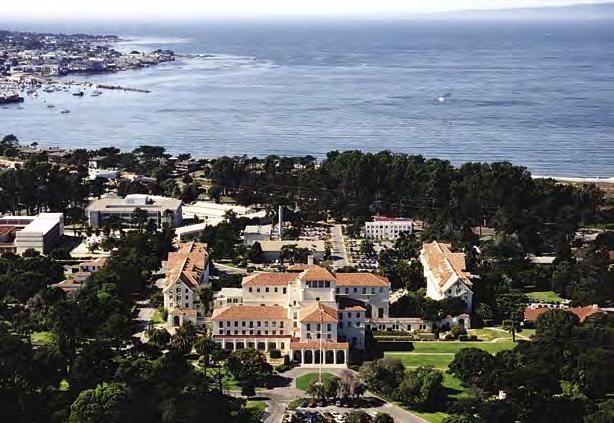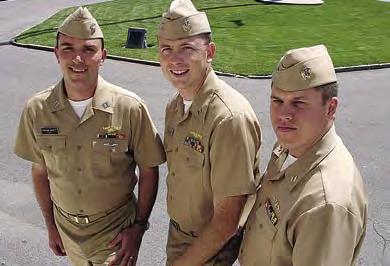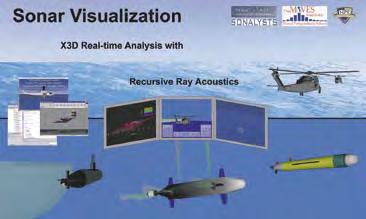
10 minute read
Naval Post Graduate School Pushes USW Envelope
Naval Post Graduate School Pushes USW Envelope USW Envelope
U.S. Navy photo
Advertisement
“The USW curriculum ensures that we fulfill our mission to increase the combat effectiveness of the Navy, while providing our students with a Master’s Degree in engineering acoustics, physical oceanography, operations research, electrical engineering (acoustical signal processing), or applied science.”
Rear Adm. Patrick W. Dunne, USN President, Naval Postgraduate School
(right) (Left to right) Naval Postgraduate School undersea warfare students Lt. Scott Cullen, Lt. James Von St. Paul, and Lt. Joseph Moore. Submariner Cullen and surface warfare officer Von St. Paul are specializing in operations research, and submariner Moore is in applied physics.
(left) Aerial view of the Naval Postgraduate School (NPS) in Monterey, California.
Future naval battles in the littoral and defense of the Sea Base, carriers, and other high value assets may rely on mission-critical undersea warfare (USW) expertise gained by USW students at the Naval Postgraduate School (NPS).
Take NPS operations research student Lt. James Von St. Paul and his thesis research on an undersea “Star Wars,” for example: When the Applied Research Laboratory at Pennsylvania State University needed quick-turnaround research assistance on the first anti-torpedo torpedo, they turned to interdisciplinary USW faculty-student teams at NPS in Monterey, Calif.
Previously an ASW officer onboard the guided missile cruiser USS Antietam (CG54) and a reactor mechanical division officer on USS Theodore Roosevelt (CVN71), Von St. Paul was tapped to assist with a mission identified by the Office of Naval Research. “I was able to bring all of my fleet experience as an ASW officer to the anti-torpedo torpedo project,” Von St. Paul said. “My thesis research was already focused on optimizing decisions for Tomahawk target matching, which had crossover applications to the torpedo targeting problem.” Von St. Paul’s master’s thesis research addresses one of the Chief of Naval Operations’ near-term ASW transformation priorities – torpedo countermeasures – directly.
Another USW student, submariner Lt. Joseph Moore, also found his NPS thesis research redirected to meet a pressing Department of Defense (DoD) need. “My main interest is in computer simulation for designing underwater shapedcharge warheads and constructing their prototypes – basically how to get more bang from the explosives,” said Moore, an applied physics degree candidate and former engineering department junior officer on USS Springfield (SSN-761). “When we learned that CENTCOM (U.S. Central Command) needed better ways to counter insurgent and terrorist threats in Iraq,

“Investment in the education of Submarine Force officers has never been more important than it is today. FY05 presents a golden opportunity to afford some of the force leaders of tomorrow an opportunity for dedicated graduate study at the Naval Postgraduate School in Monterey. NPS is the primary path for dedicated, full-time study leading to both a master’s degree and a subspecialty code. At this year’s (2004) Executive Officer Screening Board, YG 93 officers with a master’s degree screened at a rate over 15 percent higher than those without, and one in three of those with master’s degrees earned them at the Naval Postgraduate School. NPS offers the best opportunity for relevant education and exposure in fields critically important to the future of our Navy. Attending NPS is a win-win scenario for an individual officer, his family, the Submarine Force, and the Navy. Take full advantage of this opportunity today.”
Adm. Kirkland H. Donald, Director, Naval Reactors; Rear Adm. Admiral Paul F. Sullivan, Commander, Submarine Force, U.S. Pacific Fleet
I applied what I knew from my shapedcharge research to developing advanced lightweight armor to protect against improvised explosive devices (IEDs).”
“One of the great things about being a student at NPS is that you’re on a win-win fast track,” Moore noted. “You take an idea that really matters to the Navy or DoD and develop it in just 18 months.”
TRIDENT submariner Lt. Scott Cullen, an operations research student who had served as a junior officer on USS Rhode Island (SSBN-740), stressed the uniqueness of the NPS USW curriculum. “What’s most valuable about the USW program is its unique defense focus, the wide range of USW-related scientific disciplines integrated into its rigorous core courses, and the application portion of the classes specifically addressing DoD and Navy challenges,” Mediterranean, and a carrier battle group, Bacon served as Assistant Chief of Naval Operations for undersea warfare, overseeing the entire U.S. Submarine Force. One of his major roles as USW chair, established by a memorandum of understanding between NPS and the Naval Undersea Warfare Center in 2003, is to maintain liaison with operational commands, Navy laboratories, acquisition program managers, and program sponsors to link identified, prioritized Navy needs with USW student thesis topics.
Cullen said. “Fundamental knowledge of the four basic disciplines taught in the NPS USW program is vital to the success of underwater operations, and everyone who graduates from the program learns how to exploit the undersea environment to our best advantage.”
“The Naval Postgraduate School USW curriculum is a crown jewel and absolutely unique,” stressed retired Navy Vice Adm. Roger R. Bacon, inaugural chair professor for undersea warfare at NPS, who is himself an NPS alumnus in computer science and also directs the school’s USW Research Center. “You can’t get the defense-focused education in key USW core concepts – taught by world-class professors familiar with the military applications of these disciplines – at any other U.S. institution. No other university has this much faculty talent – the 24 members of our USW Academic Committee – in one place.”
Before retiring from 34 years of active duty during which he commanded two nuclear-powered submarines in the Pacific, a submarine squadron in Pearl Harbor, U.S. and NATO submarine groups in the residence at NPS are from as many as 60 allied nations.)
Vice Adm. Roger R. Bacon, USN (Ret.) Inaugural Chair Professor for Undersea Warfare, Naval Postgraduate School, and former Assistant Chief of Naval Operations for Undersea Warfare
“Our distinct advantages lie not only in the unique NPS USW course material,” Bacon continued, “but in the understanding developed from working side by side with active duty colleagues and international officers.” (Approximately one quarter of the nearly 1,600 officer students in
“Response by students and faculty to the NPS USW program continues to be enthusiastic,” said Dr. Don Brutzman, former submarine officer and Chair of the USW Academic Committee. The committee is composed of 24 faculty members who teach and advise thesis research in one or more of the USW-related academic disciplines. “Perhaps our biggest value is that all our students earn accredited degrees in traditional scientific disciplines while learning about the interdisciplinary nature of these ongoing at-sea challenges. This is unique among universities and perhaps more necessary than ever, as other fields become more and more tightly specialized.”
During the Cold War, ASW was essentially a blue-water, sub-on-sub mission, in contrast to today’s focus on the littorals. With the recent proliferation of quiet diesel submarines operating in noisy, nearshore environments and posing a growing anti-access threat, there is heightened interest and concern about USW as a vital component of littoral and expeditionary warfare – especially following the release of the CNO’s ASW Concept of Operations guidance in January.
“The Naval Postgraduate School has responded to this resurgence of USW emphasis with a series of robust, interconnected initiatives,” Bacon noted. “First and foremost is the traditional two-year in-residence USW curriculum, which began in 1973 and results in an accredited master’s degree in one of the specialization tracks – engineering acoustics, physical oceanography, operations research, electrical engineering (acoustical signal processing), or applied science. In addition, last July we added an Anti-Submarine Warfare Certificate Program by means of distance learning, which includes each of these core competencies.” The first students to earn an ASW distance-learning certificate, whose credits apply toward a full NPS master’s degree, graduate in June. All active-duty and reserve naval officers, government-laboratory engineers, afloat and ashore Navy civilians, and Navy enlisted personnel with ASW backgrounds are eligible to enroll in the ASW Certificate Program.
For recent graduates of the U. S. Naval Academy, R.O.T.C. programs, and other qualified curricula, NPS also has an inresidence, one-year Immediate Graduate Education Program (IGEP). Each year’s program typically begins in July and ends the following June. IGEP graduates earn a Master of Science degree in applied science, with a major in one of the USW core academic areas.
Central to the NPS USW master’s degree program is the thesis requirement. Each student performs the underlying research and then writes an independent master’s thesis on a topic of direct scientific and technological interest to the Navy’s technical programs, DoD, and the scientific community. Students are directly involved in cutting-edge research with world-class faculty and support staff, tackling many of the most important scientific problems facing the Navy today and preparing for future assignments as key military decision makers.
In addition to these alternatives, future NPS USW warfare students will now have another exciting new option. “Following the recent USW curriculum review by Rear Adm. Raymond Michael (‘Mike’) Klein, Deputy Director of CNO’s Submarine Warfare Division, NPS has just received
the green light for a new curriculum in unmanned systems,” said Brutzman. Students graduating from the proposed new program, which is now under review, will receive a Master of Science in Engineering Science degree (M.S.E.S.) in mechanical engineering. “For almost 20 years, NPS has had an active research program in autonomous underwater vehicles, graduating 125 thesis students under Distinguished Professor Anthony Healey, director of the NPS Center for Autonomous Underwater Vehicle Research. So we’re very excited about seeing this elevated to a new curriculum. The first unmanned systems courses – including autonomous underwater vehicles (AUVs), unmanned sensors, underwater robots, unmanned surface vehicles, and unmanned airborne vehicles – are expected to begin in January 2006. We are accepting applications now.”
“Unmanned systems, such as unmanned underwater and surface robots, are rapidly gaining prominence as near-term, rapidresponse capabilities in Navy tactical planning, which in turn raises tactical oceanography to an even more critical warfare specialty,” said Brutzman. “Recent special presentations by Rear Adm. Tim McGee, Commander, Naval Meteorology and Oceanography Command, and Rear Adm. Bill Landay, Program Executive Officer for Littoral and Mine Warfare, both stressed the importance of interlocking capabilities and expertise in each of these critical areas for USW. The focus now is on new naval capabilities that emerge from net-capable
Graphic courtesy of NPS Undersea Warfare Academic Committee
Rear Adm. John J. Waickwicz, Commander Fleet Anti-Submarine Warfare Command
forces not restricted by the limitations that long hindered past systems.”
In addition to engineering acoustics, physical oceanography, operations research, and acoustical signal processing, the NPS USW curriculum includes anti-mine warfare topics taught and overseen by the NPS Chair of Mine Warfare, retired Navy Rear Adm. Richard D. Williams III, also assistant director of the school’s USW Research Center.
“Mines are the ultimate terror weapons at sea,” reflected Lt. Moore. “The mine warfare area is definitely covered in the NPS USW program, and you can choose to specialize in it as well.” This will especially be the case with the new unmanned systems curriculum, because counter-mine operations are a high-priority UAV mission.
Another highlight of the NPS USW program is the weekly Menneken Lecture Series, featuring distinguished visiting experts in mine warfare, mine countermeasures (MCM), ASW and USW. Topics in the series have included “Offensive AntiSubmarine Warfare” by retired Rear Adm. Jerry Holland, and “The Littoral Challenge”, by Rear Adm. Bill Landay, Program Executive Officer for Littoral and Mine Warfare.
“ASW is a team mission, and naval officers of every community are enrolled in the NPS USW curriculum,” said Cmdr. John E. Joseph, program officer for undersea warfare and meteorology/oceanography. “Of the 28 naval officers currently enrolled in the in-residence program, 17 are surface warfare, five are submariners, and three are aviators. In addition, three are international naval officers – two from Turkey and one from Taiwan.”
“The NPS USW program is looking in all warfare communities for the best and brightest officers who want to make a difference in this long-standing, critical mission area of the Navy. We enthusiastically invite all eligible applicants to enroll in the master’s degree, distancelearning certificate, and IGEP programs,” says Brutzman. “Challenge us, and we’ll challenge you.”
For more information about the Naval Postgraduate School and all of its academic programs, go to www.nps.edu.
Ms. Honegger is with the Naval Postgraduate School Public Affairs Office.

(left) The SonarVisualizationRRA (recursive ray acoustics) extension of the NPS-developed “AUVWorkbench” 3-D vehicle simulation planning tool uses the Internet to query supercomputers for data inputs to sonar signal simulations.









